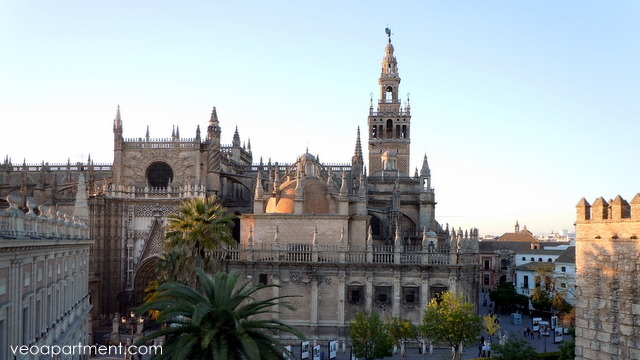At the south end of the old centre of Seville is an outstanding group of three buildings that were registered as a World Heritage Site by Unesco in 1987, comprising the Cathedral and Giralda Tower, the Alcázar Royal Palace complex and the General Archive of the Indies.

Cathedral and Giralda Tower
The Cathedral stands on the site of the former Grand Mosque built by the Almohad kings between 1184 and 1198. The Mosque was converted to a cathedral when the city was reconquered by the Christian king of Castile in 1248, but after it was badly damaged in an earthquake in 1356, the decision was taken to demolish it, and build a completely new Cathedral in its place. At the meeting of the church council in 1401 where the decision was made one of the members is said to have proposed “Let us build a church so beautiful and so great that those who see it built will think we were mad”. The work lasted for over 150 years, including substantial rebuilding after the collapse of the lantern in 1511, the Capilla Real (Royal Chapel) only being finished in 1575. The result is the world’s largest Gothic cathedral, and the third largest church in the world after Saint Paul’s and Saint Peter’s. Inside there are more than 80 chapels, and a massive gold altarpiece, as well as the tomb of Christopher Columbus. Curiosities include a stuffed crocodile outside the Puerto de Lagarto.
The Giralda Tower, now the bell tower of the Cathedral, was originally the minaret of the Mosque, the bells and upper portions, including the statue that gives the tower its name, being added in 1568. You can climb the tower up the internal ramp, and the view from the top over the roofs of the city is one of the highlights of any visit to Seville, and endlessly fascinating.
Admission is €8.75, €2 for students and pensioners. Free to disabled, under-16s, and those born or resident in Seville.
The Real Alcázar
The first fortress and palace was built as long ago as the 10th century, but little remains from this period. The outer walls that we see today are from the 11th century, but the main palace dates from the time of Peter the Cruel in the 14th century, with later additions. The palace is still an official residence of the King of Spain, making it the oldest palace in continuous use in Europe.
Much of the palace was built in the style known as Mudejar, the mix of Islamic and Christian styles that defined the period.
Highlights include the Courtyard of the Maidens (legend has it that the Moorish kings extracted an annual tribute of 100 young girls from their Christian subjects), with its reflecting pool and sunken gardens, the Baths of Lady María of Padilla, which are actually rainwater tanks beneath the palace, and the Pool of Mercury in the Palace gardens.
Admission is €8, or €3 for students and pensioners.
General Archive of the Indies
The building that now houses the General Archive of the Indies was built between 1584 and 1598 as the commodities exchange for the merchants engaged in the trade with the New World. Before that time the merchants had been in the habit of transacting their business on the steps of the Cathedral, or even inside when it was either too hot or raining, causing considerable friction with the church authorities (the contemporary depiction of the expulsion of the moneylenders from the temple above one of the doors of the cathedral may have been inspired by this).
Later, after the monopoly of the Americas trade passed to Cádiz, the building fell into disuse, until Charles III decreed in 1785 that it should be used to house all the documentation relating to the Spanish American Empire. The archive is still one of the most important in the world for historical research, although many of the documents are now in a building across the street.
Admission is free and there are often interesting special exhibitions.
We have four luxury apartments with stunning views of this very special place, the Catedral Terrace and the three Giralda Terrace apartments.
Sir, can I have ur permission to use ur article in our school’s unesco club article? Your cooperation and consideration is very much appreciated. 🙂